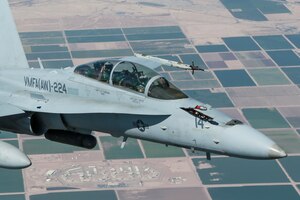By Marine Corps Sgt. David Staten DoD News, Defense Media
Activity
WASHINGTON, April 13, 2018 — Senior Navy, Marine Corps and
Air Force leaders outlined priorities for combat aviation during a House Armed
Services Committee hearing here yesterday.
Speaking for Navy and Marine Corps aviation, Navy Vice
Admiral Paul A. Grosklags, commander of Naval Air Systems Command, told
committee members he believes the DoD budget agreement covering fiscal years
2018 and 2019 is aligned with and supports the National Defense Strategy in
rebuilding military readiness while providing a more lethal force.
“The lethality which naval aviation brings to bear in
support of our nation's interest will be greatly enhanced by the increase
procurement numbers for aircraft and weapons, increased investment in the
development of new and advanced capabilities and increased funding of our
critical readiness and sustainment accounts,” Grosklags said.
Marine Corps, Navy Aviation Priorities
Grosklags provided aviation priorities for the Marine Corps
and Navy.
For the Marine Corps:
-- F-35 Lightning II aircraft procurement and sustainment;
-- CH-53K King Stallion helicopter development and
continuation of low rate initial production;
-- Marine air-ground task force unmanned expeditionary
capability, also known as MUX;
-- Completion of the H-1 upgrades procurement program
featuring UH-1Y “Venom” and AH-1Z “Viper” helicopters, the next generation of
Marine Corps utility and attack aircraft;
-- Maintaining lethality of legacy F/A-18 Hornet aircraft.
For the Navy:
-- F/A-18 super Hornet service life modernization;
-- Procurement of F-18 Block III upgrades, F-35’s, E-2 early
warning aircraft, P-8 Poseidon aircraft, CMV-22 Osprey aircraft and MQ-4C
Triton unmanned aerial vehicles; and
-- Development of the MQ-25 unmanned air system and the next
generation jammer.
A critical priority for the Navy and Marine Corps is full
funding for aviation readiness accounts, including spares, officials said.
Naval and Marine Corps leaders also told committee members
their services are committed to flight safety and are dedicated to reducing the
likelihood of accidents.
Marine Corps Lt. General Steven R. Rudder, deputy commandant
of the Marine Corps for aviation, told the committee his service is maximizing
efforts to prevent aerial mishaps, and taking corrective actions if they occur.
More money, Rudder said, is being spent on aircraft maintenance to keep older
airframes in good shape.
“We’re giving maximum amounts to our [maintenance and parts]
depots; maximum amounts to buy spares, giving max amounts to program managers
so they can fix the airplanes,” Rudder said.
The general also said the Marines are stepping up efforts to
buy new aircraft to replace older, more maintenance-prone aircraft.
Demand for Air Force Capabilities Grows
The demand for Air Force capabilities continues to grow, as
the United States experiences a more competitive and dangerous international
security environment, Air Force Lt. General Arnold W. Bunch Jr., military
deputy for the Office of the Assistant Secretary of the Air Force for
Acquisition, told the committee.
The Air Force is supporting combatant commander requirements
in response to growing challenges from Russia, China, North Korea and Iran, in
addition to the counterterrorism mission in the Middle East and around the
world, Bunch said.
Air Force spending priorities include F-35 aircraft
procurement, sustainment and modernization, KC-46 aerial refueler aircraft for
their power-projection role, and the B-21 Raider bomber development program,
Bunch said. According to the general, these efforts are key to the Air Force so
it can answer the nation's call when needed.
“The Air Force must build a more lethal and ready force,
strengthen alliances and partnerships and deliver greater, more affordable
performance,” Bunch said. “Future wars will be won by those who observe,
orient, decide and act faster than adversaries in an integrated way across all
domains.”
Bunch said his plan for the Air Force is to drive
innovation, reinforce budget discipline and deliver capabilities with greater
affordability at the speed of relevance.
“Today's modernization is tomorrow's readiness -- readiness
is not static,” the general told the committee. The Air Force, he said, will
continue its efforts to bolster readiness, increase lethality and modernize in
a cost-effective manner.

No comments:
Post a Comment